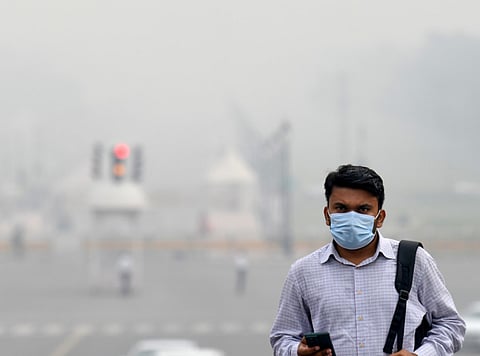Delhi smog crisis deepens: Eye disorders surge 50% as falling temperatures trap toxic air
Cold, windless air traps toxins over Delhi as residents fight back with purifiers, masks

New Delhi: Delhi’s smog crisis is tightening its grip. As the city wakes up to mornings wrapped in grey haze and the air grows heavier by the hour, doctors are warning that the toxic mix of smoke, chemicals, and dust is not just choking lungs — it’s burning eyes, damaging corneas, and blurring vision.
The capital’s worsening air quality, now among the world’s most hazardous, has triggered a 50 to 60 per cent jump in eye-related ailments this week alone, according to ophthalmologists at the All India Institute of Medical Sciences (AIIMS) and other major hospitals. The combination of post-Diwali pollution, stagnant winds, and plunging temperatures has turned Delhi’s air into a corrosive cocktail that is harming nearly every organ of the human body.
‘If the cornea gets damaged, no transplant will help’
“The number of patients suffering from dryness, burning, and watery eyes has increased sharply — both adults and children are being affected,” Prof. Sudarshan Khokhar, Professor of Ophthalmology at AIIMS, told IANS.
“If your cornea gets damaged, you may need a transplant to restore vision. But if pollution levels continue to rise, even that may not help, because the cornea itself is deteriorating from constant chemical exposure,” he warned.
Dr. Rajesh Sinha, Professor at the RP Centre, AIIMS, said outpatient visits for eye irritation have surged by half. “Many complain that their eyes feel gritty or heavy — classic signs of pollution-induced ocular allergy. Even healthy people are now walking in with redness and discomfort,” he said.
Smog’s impact on human body
Lungs: Causes asthma, chronic cough, bronchitis, and long-term respiratory damage.
Heart: Increases risk of heart attacks and hypertension due to low oxygen levels.
Eyes: Leads to itching, burning, redness, dryness, and potential corneal damage.
Brain: Long-term exposure linked to memory loss and reduced cognitive function.
Blood: PM2.5 particles enter bloodstream, affecting oxygen transport.
Children: Impairs lung development and increases allergy risk.
Elderly: More vulnerable due to weak immunity and chronic illnesses.
How Delhiites are tackling the smog
Masks & glasses: Commuters wear N95 masks and protective eyewear to reduce exposure.
Indoor purifiers: Demand for air purifiers has spiked across the NCR.
DIY filters: Some are using HEPA sheets and activated carbon cloth on fans and vents.
Eye protection: Doctors recommend lubricating eye drops and saline rinses twice daily.
Green corners: Households are adding air-purifying plants like money plant, areca palm, and peace lily.
Fitness shifts: Runners and cyclists are moving workouts indoors or to late evenings.
School alerts: Schools have cut morning assemblies and issued mask advisories for students.
Tiny particulate matter (PM2.5 and PM10) particles settle on the eye’s surface, damaging the tear film and causing inflammation. Pollutants such as nitrogen dioxide and sulfur dioxide react with eye moisture, creating chemical irritation and burning sensations.
Dr. Harbansh Lal, a Delhi-based ophthalmologist, said, “Every year after Diwali, we brace for a surge in eye complaints, but this season is worse. Cases of itching, redness, and burning have risen by 50–60 per cent. Those with dry eyes or contact lenses are struggling the most.”
A silent killer
Calling air pollution “a silent killer,” Dr. Randeep Guleria, former Director of AIIMS, told India Today toxic air is no longer just a respiratory crisis but a whole-body assault.
“Fine particulate matter like PM2.5 and ultra-fine particles can cross from the lungs into the bloodstream, travelling to every organ,” he explained. “They cause inflammation and narrowing of blood vessels, increasing risks of heart attacks, strokes, dementia, and even cancer.”
Dr. Guleria cited global data showing that 8.1 million people died in 2024 due to air pollution — more than Covid-19 deaths that year. “It’s a pandemic of deaths, but one that’s silent,” he said.
He compared Delhi’s air to smoking 8–10 cigarettes daily, warning that long-term exposure causes chronic inflammation across the lungs, heart, brain, and blood vessels.
“Nearly 70% of days in a year have unsafe air quality,” he noted. “We are breathing toxic air most of the time — and the damage is cumulative.”
Experts warn that prolonged exposure can cause chronic inflammation and lasting vision damage. “Protecting your eyes is as important as protecting your lungs,” Dr. Sinha added. “Even small steps like wearing glasses outdoors and using lubricating drops can make a difference.”
Cold air, clear sky — and trapped poison
According to the India Meteorological Department (IMD), minimum temperatures across Delhi-NCR will begin to fall from November 1, with no rainfall expected in the first week of November. The weather pattern — clear skies, cold nights, and weak winds — is ideal for trapping pollutants near the surface, worsening the Air Quality Index (AQI), which already sits in the “very poor” zone.
“The combination of cold, dry air and stagnant winds will only intensify smog formation. The first week of November could bring the worst air of the season,” said a senior IMD official.
In anticipation, the Commission for Air Quality Management (CAQM) is preparing to enforce the next phase of the Graded Response Action Plan (GRAP), which may include: a ban on construction and demolition, restrictions on truck entry into Delhi, round-the-clock road cleaning and water sprinkling, and tighter dust control and industrial checks.
Humidity levels are expected to stay between 60 and 85 per cent, increasing the likelihood of fog and smog in early mornings and evenings.
Health experts are advising residents — especially children, the elderly, and those with respiratory or eye conditions — to stay indoors during peak pollution hours and wear N95 masks when outdoors.
Sign up for the Daily Briefing
Get the latest news and updates straight to your inbox



